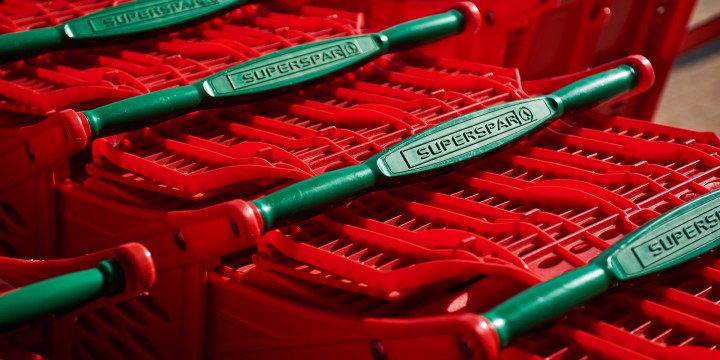THE COST OF EATING
Food prices are off their trolley — what you pay now compared to a year ago

TGIFood asked retailers for an indication of price increases over the past five years. The results were surprising. And the calculations hurt our heads.
We can only despair at the prices of kitchen staples these days. Lean beef mince has shot up in price, from around R80 per kilogram at most retailers to about R120, and a packet of bacon is likely to set you back over R50. Olive oil, even imported low-quality oils, are now well over R100. Filter coffee — one of life’s great pleasures — has become a true luxury. The last time I happened upon a packet of ground filter coffee priced at under R80 was probably circa 2022.
Food price inflation seems to be out of control, particularly if you have what has become a champagne taste on a beer budget. And in South Africa, even beer has become a luxury. Not counting Covid’s (thankfully temporary) black market price inflation, which saw bottles of Klippies fetching almost a grand while even the humble Tass was elevated to the lofty price bracket of premium products like Delaire Graff Cabernet Sauvignon Reserve or the Vilafonte Series M, a six-pack of Windhoek is now teetering at around R100.
Granted, these are the problems of an increasingly affluent few: the latest Pietermaritzburg Household Affordability Index is a depressing picture of what goes into the low-income market’s shopping basket. Year-on-year, the cost of a basic nutritional food basket of 44 items, for a family of seven members, increased by R555.41 (10% up) from R5,571.54 in June 2022 to R6,126.95 in June 2023. For the poorest members of society, that 10% increase is the difference between having 30kg of maize meal and about a 10kg packet of frozen chicken portions, or not.
In March, SA’s food prices were up 14.4% year-on-year, which is the highest rate of food inflation since March 2009. Food is the biggest single component of the Consumer Price Index, accounting for more than 15% of the basket.
Commenting on the results, Kevin Lings, chief economist at Stanlib, said the main factors influencing domestic food prices are a weaker rand, rolling blackouts, the need for producers and retailers to restore profit margins, and the deterioration of infrastructure, especially in rural areas.
“SA’s food inflation is expected to moderate to an average of 5.5% in 2024, assuming a continued slowing in global food inflation, an easing of electricity outages, an improvement in summer crop production, a stable rand and a stabilisation of margins in the food supply chain,” Lings said.
Year-on-year, food prices in SA increased 11.8% in May of 2023 compared to May 2022. Citing Stats SA data, Trading Economics says food inflation averaged 6.49% between 2009 and 2023, reaching an all-time high of 15.6% in February of 2009 and a record low of 0.6% in June of 2010.
In June 2022, The Outlier started conducting its own grocery basket comparison, tracking the prices of a 700g loaf of Albany Superior sliced white bread, or store brand; 2-litre sunflower oil (cheapest option); 2.5kg Iwisa maize meal; 2.5kg Selati white sugar; 2-litre milk (cheapest option); 2kg Tastic rice; 2.5kg Snowflake cake flour; 175g bar of Dettol herbal soap; and a 9-pack of two-ply toilet paper (cheapest option). Retailers included Spar, Woolworths, Pick n Pay, Shoprite, Checkers, Boxer, Makro and Food Lovers.
Spar and Woolworths were almost on par
This is what they found in the latest comparison: Spar and Woolworths were almost on par with their prices, with Makro offering the cheapest basket of all retailers.
With this in mind, TGIFood wanted to look at how a basket of kitchen staples, commonly bought in slightly more affluent communities, has increased in price over the past five years. We sent a list to the major retailers; only two opted to respond.
The list included 250ml cream; 300g Cheddar cheese; 250g spaghetti pasta; lean beef mince (kg); 250g filter coffee; 2.5kg bread flour; 750ml olive oil; 500g butter; 500g margarine; and 750ml canola oil.
These are their results:
Spar
Spar provided a list of its white label goods. It said its current contribution of private label to the total grocery basket, including fresh (butchery, bakery, and produce) is 21.8%. On average 21.8% of every basket that goes through Spar’s till is a private label product.

These are the YoY increases:
Butter: 13%
Margarine: 22%
Bacon: 11%
Spaghetti: 27%
Canola oil: -2%
Olive oil: 19.4%
Coffee: 12.11%
Cheese: 8%
Cake flour: 25.4%
Since 2019, Spar has increased its prices as follows:
Butter: 21%
Margarine: 58%
Bacon: 29%
Spaghetti: 56%
Canola oil: 90%
Olive oil: 25.4%
Coffee: 27.4%
Cheese: 35%
Cake flour: 63%
Woolworths
Woolworths does not sell cheese in 300g packets so they substituted a 240g/400g price over the period.
The pack size on bacon is 250g, as opposed to the industry standard of 200g.
There are a few other product differences: the Whipping Cream is Ayrshire, pasta is 100% imported durum wheat; and olive oil is also imported (therefore affected by currency fluctuations).

These are the YoY increases:
Bacon: 5.6%
Cream: 6.8%
Spaghetti: 8.9%
Lean beef mince: 6.2%
Coffee: 6.7%
Cake flour: 9%
Butter: 5.2%
Margarine: 6.4%
Cheese: 5.6%
Olive oil: 1%
Canola oil: 8.8%
Since 2019, Woolies prices have increased as follows:
Bacon: 23%
Cream: 39%
Spaghetti: 53%
Lean beef mince: 35%
Coffee: 38.5%
Cake flour: 54%
Butter: 28.6%
Margarine: 33%
Cheese: 31%
Olive oil: 5%
Canola oil: 52%
Surprisingly, both retailers’ price increases since 2019 are on par: Spar hiked its prices by 29.5% and Woolworths by 29.6%. Whatever our politicians and competition authorities might claim, we can all thank rolling blackouts, war, supply chain constraints, riots, and climate change for our food price inflation.
Someone eventually has to foot the bill and retailers, who are spending billions on keeping their fridges on, cannot take up the slack forever.
What’s more, the biggest price increases — in cake flour and canola oil — are related to the war in Ukraine so we can all thank Russia for its contribution to our economic hardship.
Individual stores and specials skew results
Mind you, individual stores and specials skew results. I was stunned to see Britos bacon pieces on special at the Rosmead Spar for just R29 and Woolworths regularly has three-for-two specials.
I’m on the fence about retailers so loyal to (perceived) value for money. When I can, I like to buy fruit and vegetables from one retailer because it has a vastly superior cold chain so the produce doesn’t vrot within days and doesn’t end up in the bin. I track meat prices between the competing retailers in my area and stock up whenever I spot a special.
And like many consumers, I use loyalty programmes to my benefit.
The 2022 Truth & Brandmapp Loyalty Whitepaper, based on an independent study of 33,000 taxpayers, suggests 73% of economically active South Africans are using loyalty programmes. Eighty six per cent of wealthier consumers use loyalty programmes, to benefit from cash back, points, discounts and free gifts or samples.
Gordon Wilson, business development director at the Achievement Awards Group, noted earlier this month that as the economy hardens and household budgets come under more pressure, loyalty programmes have become more important to help businesses retain customers, increase customer engagement and boost sales.
When times are tough, customers are more likely to switch to cheaper alternatives, downsize, or cut back on spending, which is where a well-designed loyalty programme can help businesses retain customers by offering rewards and incentives, while adding real value to customers that they keep coming back for.
“In a tough economy, businesses are often competing for a smaller pool of customers. A loyalty programme can give businesses a competitive advantage by offering a unique value proposition that sets them apart from their competitors, and gives that extra value needed to retain customers, increase engagement, and generate revenue,” he explained.
Spar’s relaunched loyalty programme is a case in point. At the end of May, Spar relaunched its Rewards programme, which saw more than a million sign-ups in less than a week. That’s likely owing to the programme no longer being limited to individual stores and offering far more than before, with instant savings on hundreds of products in Spar and TOPS at Spar stores throughout South Africa. Less than a week after the launch of the revamped programme, card registrations had reached 1,035,785.
A TrendER/infoQuest survey of the most popular consumer loyalty programmes in SA, published earlier this month, found Clicks’ ClubCard to be the leading loyalty programme in terms of membership numbers (with 71% of respondents having a ClubCard), followed by Pick n Pay Smart Shopper (66%) in second, Checkers Xtra Savings (65%) in third, Shoprite Xtra Rewards (58%) in fourth, and Capitec Live Better (53%) in fifth.
The most affordable basket
Earlier this month, a Netwerk24 comparison of 76 items for May 2023 showed that Shoprite Checkers offered consumers the most affordable basket of grocery essentials.
The news website’s inflation basket found Shoprite to be 23% — or R1,009 — cheaper and Checkers 20% — or R866 — than the “priciest supermarket chain”.
Comparing the cost of items such as fruit and vegetables, dairy, meat, fish, eggs (before the highly pathogenic avian influenza hit the Cape, which has sent egg prices soaring) sauces, spreads, dry ingredients, snacks and treats, pet food, tin foil, drinks, toiletries and detergents, a poll by the media outlet also named Checkers as South Africa’s most popular supermarket, with 82% of the nearly 4,000 respondents saying it is their supermarket of choice.
Everyone’s feeling the pain: The staples seen in the kitchens of more affluent gastronomes — extra-virgin olive oil, lean mince and filter coffee — have shot up in price. In many cases, one can’t even blame a wobbly exchange rate. DM
















When one considers how we ate only 50 years ago, when food was bought from the local butcher or greengrocer, and the produce was local and seasonal, there was no waste, and no luxury produce (or maybe that was just in my household). We bottled fruit for off season and made jams with the damaged excess. As I aged, food became plentiful and we wasted food. My biggest surprise was the incredible food waste in the USA where triple portions is the norm and throwing half eaten massive hamburgers is not considered. It is not a bad thing to have to carefully select our food, not buy more than we need and use it all.
Maybe an already expensive chainstore will have lower % price increases because they already have a higher margin? I value my time so driving around my local stores to find the bargains or going to a megastore with miles of shelves is not my choice. I like my smaller nearby pick and pay where the parking and aisles require less distance walking and familiarity means speed. But within those parameters I definitely hunt for value.
Two thoughts come to mind. The first is that those with just a small piece of ground and the nous to grow their own food have by far the most affordable basket of grocery essentials. What’s more they have not been sprayed with toxic ecocides.
Spinach, kale, broccoli, cabbages, lettuce, mealies, butternut, susu, green onions, radishes, peppadews, beans and peas are so easy to grow; these are the “real foods.”
The second is that SA needs to do some serious thinking about what constitutes “grocery essentials”. We lie in the ten most unhealthy countries in the world; the reasons are complex but much of it is that we really do think that Albany Superior sliced white bread, Iwisa Number one super maize meal, Selati white sugar, Tastic white rice and Snowflake cake flour constitute real essential food.
Ask any nutritionist; these are amongst the most unhealthy “foods” available. None of them should be in any basket of “grocery essentials;” the dietary fibre, phytonutrients, vitamins, minerals, essential oils and much of the protein have been stripped from them. They are indisputably the cause of the chronic degenerative diseases that are rampant in South Africa; obesity, diabetes, stunting, cancer and CV disease.
A very large (400g) bowl of unrefined mealiemeal pap (20c) with a tsp of natural honey(10c), a tsp of butter(50c) and 1/5L of milk(27c) would give a child an excellent start to the day for just over R1. Add an egg and a plate of spinach and stunting would be history.
I agree with your point about healthy foods, but milk – 1/5L of milk (27c) – at R1.35 a litre? Thank you for joining us from the 1980s.
10c/5g of honey is R7.50 for a 375g bottle. 50c/5g of butter is R50 for 500g. Clearly Barrie’s wife does the shopping.
I do the shopping in our household and I can’t help but feel that there is collusion between the big chains as there is virtually no substantial difference in the prices charged by any of them – specials excluded.
The markup on the manufacturer’s prices seems identical – I pay R25,99 at the Fair Cape factory shop for 1kg plain yogurt. The identical article in Checkers or Pick n Pay sells at about R35,00, sometimes more. Considering that the supermarkets pay Fair Cape far less than their factory price, you’re looking at a markup of somewhere north of 50%! That’s price gouging in my book.
Another issue is that of LPG. The price is regulated by the Dept of Energy although seldom publicized as is petrol and diesel. I have experience price gouging by several garages who are adding 10 – 15% onto the regulated price. Complaints to the D0E fell on deaf ears although SASOL did follow up and seem to have stamped out the practice at my local filling station.
Food prices ( and everything else) are going to go up no matter what….the government should consider more items as VAT free if they are seriously concerned about the really poor not being able to feed themselves. It also might be an idea for Social Grants to be given as food stamps so the money is not wasted on Nail Salons, booze and Hair braids!